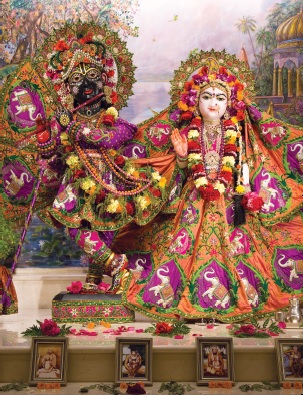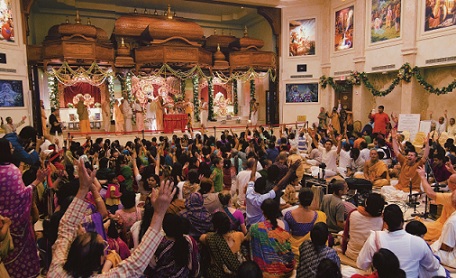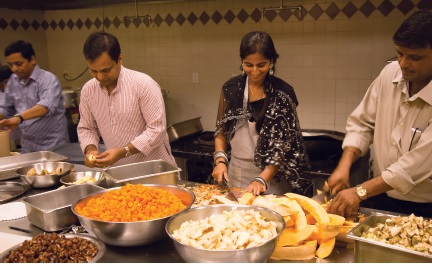
A dedicated congregation has developed the Hare Krishna temple in Houston into a vibrant center of devotion.
Texas is a Big state, but Srila Prabhupada’s disciple Dina Bandhu Dasa recalls how the International Society for Krishna Consciousness in Houston, Texas, began in a small way.
“When my wife [akuti Devi Dasi] and I arrived in Houston in 1971,” he says, “Prahladananda Dasa was the temple president at 406 Gray St. It was a dilapidated two-story wooden building just outside downtown, in a very bad neighborhood. The plaster was no longer on the walls; only the lathe was there, and the wind used to blow right through the wood siding into the temple room. We felt the place was haunted.”
He and akuti had come to Houston in the wake of the pioneering devotees who brought Krishna consciousness to Texas – Viṣṇujana Swami and his brahmacari assistant, Srinatha Dasa. In 1970 the two saffron-clad monks hitchhiked west on U.S. Interstate 10 from Florida and got dropped off in Houston, sometimes called “Space City,” as it is a major NASA communications center. In February 1971 Prabhupada wrote to Viṣṇujana in Houston to encourage him in his service there.
More than a decade later, after the devotees had moved to another building, Kalakaṇṭha Dasa served as Houston’s temple president.
“In 1984,” he says, “ISKCON Houston was in a damaged building in an unattractive part of downtown on Rosalie Street. Rats were a constant problem, and our small band of devotees struggled to serve Sri Sri Gaura-Nitai nicely.”
Houston’s Indian Community
With a warm climate similar to that of India, an economy energized by an oil boom from the late 1970s to mid- 1980s, and easing U.S. immigration laws that enabled more foreign nationals to work in America, Houston’s Indian population grew. While the new arrivals came mainly to improve their standard of living, many were happy to discover the Hare Krishna temple on Rosalie Street, simple as it was, with prasada, spirited kirtanas, and effulgent deities of Caitanya Mahaprabhu and Nityananda Prabhu – called Sri Sri Nitai-Caitanyacandra.
The temple members were all non- Indians, though one of them, Brahmatirtha Dasa, had been a Peace Corps volunteer in India and had had lively talks with Srila Prabhupada (recorded in Perfect Questions, Perfect Answers). In 1975, while at a grocery store shopping for the temple, Brahmatirtha met young Deepak Patel and invited him to the Sunday feast. Deepak, from Gujarat, western India, was a mechanical engineering graduate who had recently started working in Houston.
Fascinated to meet an American Vaiṣṇava in dhoti and tilaka, Deepak, who was not married, enjoyed the Sunday feast, moved near the temple, began coming daily, and even stayed at the temple on weekends.
“There were only five or six devotees at that time,” Deepak recalls, “and I felt at home. They taught me to wear a dhoti, and every Sunday I would go with the devotees to chant hari-nama at Herman Park.”
At Brahmatirtha’s request, Deepak began his first temple service: every Saturday he would shop for groceries and other temple supplies. Even though he has worked fulltime since the mid-1970s (and later married and raised three daughters with his wife, Subhadra Devi Dasi), Deepak has continued this shopping service uninterrupted for the last forty years. In 1984 he received initiation and the name Dvarakanatha Dasa from Tamal Krishna Goswami, and for nearly thirty years he has blissfully performed temple deity worship several days a week.
A New Temple Location
Dvarakanatha Dasa recalls that when Tamal Krishna Goswami became ISKCON’s Governing Body Commissioner (GBC) for Texas, he wanted to remodel the old Rosalie Street temple but faced zoning restrictions, scarce parking, and a declining neighborhood. When a developer offered to buy the Rosalie property in 1984, Goswami decided to move the temple to its current location, a larger property on West 34th Street. In 1986 truly Texas-sized deities, Sri Sri Radha– Nila-Madhava, were installed. And in 1990, B. B. Govinda Swami brought an unusually large śila (stone) from Govardhan Hill in Vrindavan to be worshiped on the temple altar.
Although the new place had potential, Tamal Krishna Goswami knew that an important devotional resource was largely untapped: the Indian congregation. After the deity installation, Goswami asked an Indian devotee to serve as temple president, and he invited uninitiated Indian congregational members – with jobs and families – to become board members and oversee the temple finances and other matters.
Goswami encouraged the board members and their families to increase their chanting and other devotional practices. When asked to perform a particular service, if they protested, “We are not qualified,” Goswami would reply, “Become qualified.” Eventually many devotees of Indian ancestry received initiation, beginning with Caitanya Dasa (who became the temple’s head pūjari in 1993), his wife Draupadi Devi Dasi, his father Janaka Maharaja Dasa, and Dinanatha Dasa.
In 1992 Śyamasundara Dasa, from Gujarat, became the temple president, a service he performed, while keeping a full-time job, until his recent retirement. He led an extraordinary effort to design, finance, and build the impressive state-of-the-art temple that recently celebrated its grand opening.
Houston’s Bhakti-vrksa Group
Organized by the couple Advaitacandra Dasa and Kalaśuddha Devi Dasi, once a week about two hundred devotees meet in eleven groups (known as Bhakti-vṛkṣa, or “tree of devotion”) in Houston-area residences to chant, discuss Krishna conscious topics, and enjoy a prasada dinner. Although initially Krishna consciousness was new to many, a number have taken spiritual initiation and offer valuable services such as cooking, deity worship, book distribution, management, and outreach. While most of the Bhakti-vṛkṣa participants are from the Indian community, one group consists mainly of westerners, and a Hispanic group meets intermittently.
David Garvin exemplifies the benefits of the Bhakti-vṛkṣa experience. A practitioner of Buddhist meditation for twenty years (including nearly two years in monasteries in Thailand and Japan), in 2010 he received copies of Srila Prabhupada’s books in Dallas and Houston. Impressed, he attended talks by a visiting ISKCON swami, and a devotee invited him to join the Friday evening Bhakti-vṛkṣa group in Sugarland, a Houston suburb near his home.
Every Friday evening David enjoyed philosophical discussion, kirtana, devotee association, and prasada. Enlivened, he began to distribute Srila Prabhupada’s books at outreach events and assist in Bhakti-vṛkṣa programs. He was asked to head the temple’s Bhaktivedanta Book Trust department, and with the help of about fifteen volunteer distributors, the book sales have increased each year since 2012. Recently, David received initiation and the spiritual name Dayala Nitai Dasa.

In 2000 a South Indian couple – Saraṅga Ṭhakura Dasa and Seva-priya Devi Dasi – were among four families in Houston’s first Bhakti-vṛkṣa group, near downtown. When the families eventually moved to different suburbs, they missed the Friday spiritual get-togethers and formed new groups. Currently, Saraṅga Ṭhakura and Sevapriya host a Bhakti-vṛkṣa program in their home in Katy, Texas. And while the adults meet, their fourteenyear- old son Devesh leads the kids, joined by his younger sister, Aaradita. Although Saraṅga Ṭhakura has a fulltime job, he is a member of the sixdevotee temple management team and performs temple deity worship thrice weekly. Seva-priya homeschools her children, yet she also cooks for and dresses the temple deities and organizes a Bhagavad-gita camp attended by about sixty-five children each summer. At outreach events the whole family distributes books and serves prasada, and Devesh plays the mṛdaṅga drum and often leads kirtanas.
ISKCON Youth
A number of youth have grown up along with the temple, and they like devotional service, especially kirtana. Although now busy with college or jobs, they exuberantly enhance temple kirtanas and render a variety of services. Several young people who attended the temple Sunday school now teach in the Sunday school themselves.
When I first heard seventeen-yearold Anish Pillai chanting melodically on the harmonium before Sri Sri Radha–Nila-Madhava in 2007, I felt hope for the future of ISKCON in Houston. Now, as Nila-Madhava Dasa and a recent college graduate, he works in hospital administration at Houston Medical Center. His youth kirtana group, Jiva Jago, has recorded a CD, and they often chant at temples, festivals, and yoga centers.
New Temple School
On Radhaṣṭami in 2014, Goswami Academy opened for pre-kindergarten children, with plans to expand through grade four. Emphasizing both creative academics and spiritual values, the school, led by Śubra Devi Dasi, an experienced teacher and administrator, is located in the temple’s spacious Gauranga Hall.
Prasada Distribution
For twenty years Krishna Kṛpa Dasa served prasada to Rice University students through a vegetarian club, and in the past the temple has provided prasada to Houston’s SEARCH Homeless Services, the SHAPE Center, and Our Lady of Guadalupe church. In August 2005, when 150,000 New Orleans evacuees took shelter in Houston after Hurricane Katrina, devotees delivered hot prasada to thousands of refugees. Currently the devotees provide extra prasada to Food Not Bombs and serve thousands at outdoor festivals.
Outreach Events
On visits to Houston, Tamal Krishna Goswami encouraged devotees to teach Krishna consciousness not only to Houston’s Indian community but also to people of all backgrounds. In the late 1990s they brought prasada and kirtana to a yoga center run by a Peruvian gentleman. Intrigued, a Hispanic yoga student decided to come to maṅgala-arati at 4:30 A.M. to meditate. She loved the temple, became a devotee, received the name Manasi Gaṅga Devi Dasi, and is now on the temple management team. In recent years devotees have served prasada and distributed books at the Texas Yoga Association Convention and chanted at several yoga centers.
Gurubhakti Devi Dasi (Dr. Hansa Medley), a medical doctor, serves as temple outreach coordinator. Devotees set up literature tables and prasada booths at many festivals, including Houston International Festival, Summerfest, Bayou City Art Festival, White Linen Festival, and Vegfest. They also chant on a decorated vehicle in the annual Houston Art Car Parade, attended by 100,000 Houstonians each spring. The devotees perform kirtana and distribute prasada and books at the annual Houston observance of Earthdance, a simultaneous global dance for peace in over a hundred cities worldwide. In recent years the devotees have helped an Orissan family celebrate Jagannatha Rathayatra at Discovery Green, a prestigious downtown Houston venue.
Interfaith Support
After the Kazakh government raided the Hare Krishna community in Kazakhstan in 2006, B. B. Govinda Swami toured the West to gather support. When he and his group of chanters visited Houston, the devotees held a fund-raising concert and dinner attended by congregation members and representatives of temples, churches, and mosques.
Gurubhakti Devi Dasi is on the board of advisors of Hindus of Greater Houston (HGH), which represents fifty temples and an estimated 120,000 Indo-Americans in Greater Houston. In 2010, HGH asked young devotees to perform kirtana on the main stage at their Janmaṣṭami festival at Houston’s George Brown Convention Center, and HGH widely promoted a talk by Radhanath Swami. The temple works also with Interfaith Ministries of Greater Houston (IM), which refers school and church groups for temple tours. IM’s president, Rabbi Elliot Gershenson, commended the devotees at the temple opening.
Devotee Care
In 2010, when Jananivasini Radha Devi Dasi, a disciple of Bhaktitirtha Swami, was passing away in Houston, Saṅgita Devi Dasi (Susan Pattinson, R.N.) visited to try to help. A professional hospice nurse and author of The Final Journey: Complete Hospice Care for Departing Vaishnavas, she also taught a seminar on devotee care. When she encouraged Houston devotees to form a Vaiṣṇava care team, about fifteen volunteered, and they have helped several departing devotees. One of the volunteers is an elderly Bengali devotee, Krishna Bhakti Devi Dasi. Her husband, Dr. P. K. De, developed a water filter for temple kitchens and donated several to the Mayapur temple.
A Heavy Yet Delicate Move
Before the new temple opening, Their Lordships – 1,300-pound Sri Nila- Madhava and His 900-pound consort, Sri Radha – had to be safely conveyed thirty-five yards from the old temple to Their new altar. Yaśomati-nandana Dasa, who had moved Radha–Nila- Madhava onto Their original altar twenty-eight years earlier, came from New York to help. Using a heavy-duty handcart, the devotees carefully rolled each deity up a specially built ramp, one at a time, as Nila Madhava Dasa led the prayerful devotees, including Giriraja Swami and Ṛtadhvaja Swami, in a sweet kirtana. Although the devotees were concerned, the deities moved safely up the ramp and onto the altar.
The New Temple
Just before the grand opening, Allan Turner, a senior reporter for Houston’s largest newspaper, The Houston Chronicle, wrote, “Built on the site of a former Baptist church, Houston’s new Hare Krishna temple seems impressive by any measure.” Outside, the top of the cakra (disc) crowning the main temple dome is 98 feet above the ground. Inside, a massive twelveton canopy of eight teakwood domes hangs above the altar. Seven artisans in Kerala, South India spent seven years hand carving the canopy and the matching temple doors. Marble from Spain, arrayed in ornate patterns including lotus designs, bedecks the temple floor.

Whether the event is a grand opening or a weekly Sunday Love Feast, the temple kitchen always provides plenty of opportunity for hands-on service to the Lord.
Devotees Who Made It Happen
Congregational member Arun Kothari, a general contractor, donated time, expertise, and money over many years and logged thousands of miles in his car. Vaibhavi Devi Dasi advised on color schemes and the octagonal shape of the inner domes, and Keśava Bharati Goswami gave important aesthetic feedback. Substantial financial support came from the late Dr. Raj Dhingra.
The Grand Opening
On May 16–18, 2014, the celebration attracted ten thousand visitors, ten ISKCON sannyasis, and Houston pioneers such as Dina Bandhu Dasa. Friday night featured an interfaith program, and over the weekend auspicious rituals were performed to inaugurate the temple and install new small deities, Sri Sri Radha-Giridhari. The guests enjoyed performances by B. B. Govinda Swami’s Kazakhstani chanters, the Mayapuris, the Houstonbased United Nations Association International Choir, and seventeenyear- old Carnatic vocalist Kruthi Bhat, named top vocalist in the 2014 worldwide Carnatic Idol competition and a violinist and cellist in the Houston Symphony Orchestra. More than five hundred students from thirty-five Houston-area dance and music schools, including an ISKCON Houston girls’ dance group, performed on two festival stages.
Tamal Krishna Goswami often spoke of the need for a vegetarian restaurant at the temple, and one is being planned. Devotees have built or moved into more than twenty homes within walking distance of the temple, and others have bought plots of land with the intention to build homes. The temple has purchased several acres directly across the street, with plans to build a block of twenty-one apartments for devotees or friends of the temple.
Having built guest rooms and hosted events such as the 2014 ISKCON North American Education Symposium, the temple hopes to host more seminars and retreats. Devotees are developing plans for a new brahmacari ashram and an ashram for women. Also under consideration is the idea of opening a center in downtown Houston.
Like Sudama Brahmana
Thirty years after his stint as temple president, Kalakaṇṭha Dasa returned to Houston for the grand opening. As he marveled at the deities’ beautiful new setting, a striking realization came to him: “To me, it was interesting to see at the back of the new temple building a wonderful bas-relief sculpture that depicts Sudama Brahmaṇa’s visit to Lord Krishna in Dwarka. Sudama was supposed to ask charity from Krishna , but he forgot, being overwhelmed by the Lord’s kindness. After leaving Dwarka and returning to his shack, Sudama was amazed to find that it had been transformed into an opulent palace, unmatched by the demigods’ palaces in heaven. To remember that Rosalie Street property – and to see what is here today – I now know something of how Sudama felt.”
Sarvabhauma Dasa, a disciple of Tamal Krishna Goswami, is based in Houston, where he engages in various Krishna conscious teaching and writing projects.
